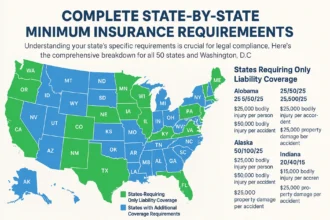
Did you know that drivers in the most expensive states for car insurance pay over $3,900 annually – that’s more than double what drivers in cheaper states spend? If you’re living in one of these high-cost states, you’re likely paying thousands more than necessary for your auto coverage.
Compare the Best Insurance Rates Now →
The reality is stark: your zip code is one of the biggest factors determining your car insurance premium. But here’s the good news – even in the most expensive states, you can dramatically reduce your costs with the right strategies and by choosing the right insurer.
Why Car Insurance Costs Are Skyrocketing in Certain States
Before diving into the most expensive states, it’s crucial to understand why insurance premiums have reached unprecedented levels in certain regions. The national average cost of full coverage car insurance has risen to $2,543, representing a staggering 26% increase from the previous year.
Several factors are driving these dramatic cost increases:
- Extreme weather events causing widespread vehicle damage
- Rising healthcare costs affecting personal injury claims
- Increased litigation and fraudulent claims
- Higher vehicle repair costs due to advanced technology
- Growing number of uninsured drivers shifting costs to insured motorists
The Top 10 Most Expensive States for Car Insurance in 2025
Based on comprehensive data analysis, here are the states where drivers pay the highest premiums for full coverage car insurance:
1. Florida – $3,945 Annual Average
Percentage of income spent on car insurance: 5.69%
Florida claims the unfortunate title of the most expensive state for car insurance. The Sunshine State’s high costs stem from:
- Frequent catastrophic weather events (hurricanes, flooding)
- High rates of insurance fraud
- No-fault insurance laws that haven’t reduced litigation as intended
- Large population of uninsured drivers
2. New York – $3,840 Annual Average
Percentage of income spent on car insurance: 4.83%
New York’s expensive car insurance reflects:
- Dense urban areas with high accident rates
- Severe credit score penalties – poor credit can add almost $4,200 to annual premiums
- High cost of living affecting repair and medical costs
- Complex no-fault insurance requirements
3. Louisiana – $3,618 Annual Average
Percentage of income spent on car insurance: 6.53%
Louisiana drivers face the highest percentage of income spent on car insurance at nearly 7%. Contributing factors include:
- Frequent severe weather and flooding
- High litigation rates
- Significant population of uninsured motorists
- Dense traffic patterns in major cities
Find Your State’s Best Rates →
4. Nevada – $3,549 Annual Average
Percentage of income spent on car insurance: 4.91%
Nevada’s high rates are driven by:
- Las Vegas tourism creating unique driving risks
- Relaxed alcohol laws contributing to DUI incidents
- Desert climate extremes affecting vehicle maintenance
- High number of rental car incidents
5. Michigan – $3,356 Annual Average
Percentage of income spent on car insurance: 5.01%
Michigan’s expensive insurance costs result from:
- Historic no-fault laws with unlimited personal injury protection
- Highest premium increase after accidents – up to $1,706 annually
- High number of uninsured drivers
- Severe winter weather conditions
6. Colorado – $2,902 Annual Average
Percentage of income spent on car insurance: 3.25%
Colorado’s mountainous terrain and weather create unique challenges:
- Frequent hail damage from severe storms
- Dangerous mountain driving conditions
- High population density in Denver metro area
- Increasing number of uninsured drivers
7. Missouri – $2,801 Annual Average
Percentage of income spent on car insurance: 4.32%
Missouri experienced the largest premium increase of any state – a shocking 44% jump from 2023 to 2024. Factors include:
- Severe weather events (tornadoes, hail)
- High litigation rates
- Increased vehicle theft in urban areas
- Rising healthcare costs
8. Pennsylvania – $2,790 Annual Average
Percentage of income spent on car insurance: 3.89%
Pennsylvania’s costs reflect:
- No-fault insurance laws
- Large driving population
- High accident rates in Philadelphia and Pittsburgh
- Expensive vehicle repair costs
9. California – $2,697 Annual Average
Percentage of income spent on car insurance: 2.95%
Despite high premiums, California drivers spend a lower percentage of income on insurance due to higher average incomes:
- Severe traffic congestion (LA and SF among worst nationally)
- Wildfire risks affecting vehicle claims
- High cost of living impacting all services
- Restrictions on credit score usage in pricing
10. Rhode Island – $2,683 Annual Average
Percentage of income spent on car insurance: 3.28%
Rhode Island’s small size doesn’t protect it from high costs:
- Dense urban population
- High vehicle repair costs
- Severe winter weather
- Limited insurer competition
What Makes These States So Expensive? Key Cost Drivers
Understanding why certain states have astronomical insurance costs helps you make informed decisions about coverage and providers.
Weather-Related Factors
Extreme weather events are the #1 driver of high insurance costs. States like Florida, Louisiana, and Colorado experience:
- Hurricanes and flooding
- Severe hailstorms
- Tornadoes and severe thunderstorms
- Wildfires (California)
These events generate thousands of claims simultaneously, straining insurance company resources and driving up premiums for everyone.
Legal and Regulatory Environment
No-fault insurance laws in states like Florida, Michigan, and New York were designed to reduce litigation but have had mixed results:
- Higher personal injury protection requirements
- Increased fraud opportunities
- Complex claim processes
- Limited ability to sue for damages
Demographic and Economic Factors
Several demographic trends contribute to higher costs:
- High population density increasing accident likelihood
- Large numbers of uninsured drivers (up to 20% in some states)
- Rising healthcare costs affecting injury claims
- Increased vehicle values and repair costs
How to Save Money on Car Insurance in Expensive States
Even in the most expensive states, you can significantly reduce your insurance costs with these proven strategies:
1. Shop Around Regularly
Insurance rates vary dramatically between companies, even in the same state. The same driver profile can see differences of $1,000+ annually between insurers.
Expert Tip: Compare quotes from at least 3-5 insurers annually. Rates change frequently, and loyalty doesn’t always pay.
2. Optimize Your Coverage Levels
Tailor your coverage to your specific needs:
- Increase deductibles to lower premiums (common savings: 10-25%)
- Drop comprehensive/collision on older vehicles worth less than $3,000
- Adjust liability limits based on your assets (but don’t go below state minimums)
3. Maximize Available Discounts
Most insurers offer numerous discounts that can stack for maximum savings:
- Multi-policy discounts (auto + home): 5-25% savings
- Good driver discounts: 10-15% for clean records
- Defensive driving courses: 5-10% savings
- Safety features discounts: 5-15% for anti-theft devices, airbags
- Low mileage discounts: 5-15% for driving less than 10,000 miles annually
4. Improve Your Insurance Score
Your credit-based insurance score significantly impacts rates in most states:
- Pay bills on time to improve credit
- Reduce credit utilization below 30%
- Monitor credit reports for errors
- Maintain older accounts to show credit history
5. Consider Usage-Based Insurance
Telematics programs can provide substantial savings (up to 40%) for safe drivers:
- Safe driving rewards for good habits
- Low mileage discounts for infrequent drivers
- Real-time feedback to improve driving
State-Specific Minimum Requirements: What You Need to Know
Understanding your state’s minimum requirements is crucial for legal compliance and cost management. Here’s what drivers in the most expensive states must carry:
| State | Minimum Liability Coverage | Additional Requirements |
| Florida | 10/20/10 | PIP ($10,000) |
| New York | 25/50/10 | Uninsured Motorist |
| Louisiana | 15/30/25 | – |
| Nevada | 25/50/20 | – |
| Michigan | 50/100/10 | PIP, Property Protection |
| Colorado | 25/50/15 | – |
| Missouri | 25/50/25 | Uninsured Motorist |
| Pennsylvania | 15/30/5 | Choice of tort/no-fault |
| California | 15/30/5 | – |
| Rhode Island | 25/50/25 | – |
Important Note: While these are legal minimums, insurance experts strongly recommend higher limits to protect your assets in expensive states where lawsuits and medical costs are higher.
The True Cost of Car Insurance: Beyond Premium Payments
When evaluating car insurance costs, consider the total financial impact:
Income Percentage Analysis
The most expensive states force drivers to dedicate a significant portion of their income to insurance:
- Louisiana: 6.53% of income
- Florida: 5.69% of income
- Michigan: 5.01% of income
- Nevada: 4.91% of income
Hidden Costs to Consider
- Deductible payments after accidents
- Rental car coverage during repairs
- Gap insurance for financed vehicles
- Opportunity costs of overpaying for insurance
Expert Insights: What Insurance Professionals Recommend
Cindy Baroway, Executive Director of Risk Management & Insurance at the University of Colorado Denver, emphasizes several key factors that drive state-by-state variations:
“Car insurance rates can vary from state to state based upon various factors including required minimum liability rates, jury verdict awards for auto accident cases, PIP requirements, number of uninsured motorists, types of storms that damage cars, and frequency of auto thefts and vandalism.”
Professional Recommendations for High-Cost States:
- Maintain excellent driving records – even minor violations can trigger major premium increases
- Increase deductibles strategically – balance out-of-pocket risk with monthly savings
- Take advantage of driver training courses – particularly valuable for new and senior drivers
- Regular policy reviews – insurance needs change over time
- Consider bundling policies – multi-policy discounts can be substantial
Common Mistakes That Cost You Money
Avoid these costly errors that can increase your premiums unnecessarily:
1. Staying Loyal Too Long
Loyalty penalty: Many insurers raise rates for long-term customers, assuming they won’t shop around.
2. Choosing Coverage Based on Price Alone
Cheap isn’t always better: Low-cost insurers may have poor claims service or financial instability.
3. Ignoring Credit Score Impact
Credit neglect: Poor credit can increase premiums by 50-100% in most states.
4. Not Reporting Life Changes
Missed discounts: Marriage, homeownership, or job changes can trigger new discounts.
5. Accepting the First Quote
Lack of comparison: Not shopping around can cost thousands annually.
How to Compare Insurance Rates Effectively
Smart comparison strategies can save you hundreds or thousands annually:
1. Use Multiple Comparison Tools
- Independent agent quotes for personalized service
- Online comparison sites for quick overview
- Direct insurer quotes for best rates
2. Compare Identical Coverage
Ensure you’re comparing:
- Same coverage limits
- Identical deductibles
- Same additional coverages
3. Read the Fine Print
Pay attention to:
- Claim filing procedures
- Coverage exclusions
- Discount requirements
- Rate increase policies
Future Trends: What to Expect in High-Cost States

Several trends will continue impacting insurance costs in expensive states:
Climate Change Impact
Increasing severity of weather events will likely drive costs higher in vulnerable states like Florida, Louisiana, and Colorado.
Technology Integration
Advanced driver assistance systems (ADAS) are making repairs more expensive but may reduce accident frequency.
Regulatory Changes
State-level reforms in no-fault states may provide some relief, but changes are typically gradual.
Market Consolidation
Insurer departures from high-risk states may reduce competition and increase costs.
Take Action: Your Next Steps to Lower Insurance Costs
Don’t let high state insurance costs drain your budget. Here’s your action plan:
Immediate Actions (This Week):
- Gather your current policy details
- List all household drivers and vehicles
- Research your state’s minimum requirements
- Start collecting quotes from multiple insurers
Short-Term Actions (This Month):
- Complete driver training courses for discounts
- Bundle policies with home/renters insurance
- Review and adjust coverage levels
- Install safety devices for additional discounts
Long-Term Strategies:
- Maintain excellent driving records
- Improve credit scores for better rates
- Consider relocating if insurance costs are prohibitive
- Review policies annually for better deals
Start Saving Today – Compare Rates →
Conclusion: Don’t Let High Costs Keep You Underinsured
Living in one of the most expensive states for car insurance doesn’t mean you’re stuck with astronomical premiums. By understanding why costs are high, shopping smart, and optimizing your coverage, you can achieve significant savings while maintaining adequate protection.
Remember, insurance rates change frequently, and what’s expensive today might be competitively priced tomorrow. The key is staying informed, shopping regularly, and taking advantage of every available discount and cost-saving strategy.
The bottom line: Even in the most expensive states, proactive drivers can save hundreds or thousands annually by making informed decisions about their car insurance coverage.
Ready to start saving? Compare personalized quotes from top insurers in your state today – rates can change daily, so see what you qualify for now.
In another related article, Can I Insure a Car Not in My Name? Complete Guide for 2025 (Plus Legal Alternatives)





